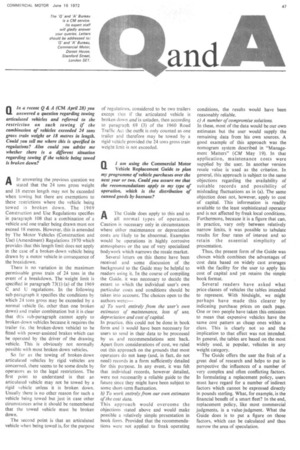I am using the Commercial Motor Vehicle Replacement Guide to
Page 49

If you've noticed an error in this article please click here to report it so we can fix it.
plan my programme of vehicle purchases over the next year or two. Could you assure me that the recommendations apply to my type of operation, which is the distribution of canned goods by boxvans?
AThe Guide does apply to this and to all normal types of operation. Caution is necessary only in circumstances
where either maintenance or depreciation costs are likely to be abnormal. Examples would be operations in highly corrosive atmospheres or the use of very specialized bodywork which narrows the resale market.
Several letters on this theme have been received and some discussion of the background to the Guide may be helpful to readers using it. In the course of compiling the Guide, it was necessary to decide the extent to which the individual user's own particular costs and conditions should be taken into account. The choices open to the authors were:— a) To work entirely from the user's own estimates of maintenance, loss of use, depreciation and cost of capital.
In practice, this could not be done in book form and it would have been necessary for users to send in their data to be processed by us and recommendations sent back. Apart from considerations of cost, we ruled out this approach on the grounds that most operators do not keep (and, in fact, do not need) records in a form sufficiently detailed for this purpose. In any event, it was felt that individual records, however detailed, were not necessarily a reliable guide to the future since they might have been subject to some short-term fluctuation.
Li) To work entirely from our own estimates of the cost data.
This approach would overcome the objections stated above and would make possible a relatively simple presentation in book form. Provided that the recommendations were not applied to freak operating conditions, the results would have been reasonably reliable.
c) A number of compromise solutions.
In these, most of the data would be our own estimates but the user would supply the remaining data from his own sources. A good example of this approach was the nomogram system described in "Management Matters" (CM May 19). In that application, maintenance costs were supplied by the user. In another version resale value is ' used as the criterion. In general, this approach is subject to the same objections regarding the availability of suitable records and possibility of misleading fluctuations as in (a). The same objection does not, however, apply to cost of capital. This information is readily available to the least sophisticated operator and is not affected by freak local conditions. Furthermore, because it is a figure that can, in practice, vary only between relatively narrow limits, it was possible to tabulate results for four rates of interest and so retain the essential simplicity of presentation.
Thus, the present form of the Guide was chosen which combines the advantages of cost data based on widely cast averages with the facility for the user to apply his cost of capital and yet retains the simple book format.
Several readers have asked what price-classes of vehicles the tables intended to represent. With hindsight, we might perhaps have made this clearer by indicating purchase prices on each page. One or two people have taken this omission to mean that expensive vehicles have the same cost pattern as cheap ones within a class. This is clearly not so and the implication to that effect was not intended. In general, the tables are based on the most widely used, ie popular, vehicles in any weight category.
The Guide offers the user the fruit of a great deal of research and helps to put in perspective the influences of a number of very complex and often conflicting factors. In formulating a replacement policy, users must have regard for a number of indirect factors which cannot be expressed directly in pounds sterling. What, for example, is the financial benefit of a smart fleet? In the end, replacement policy, like most commercial judgments, is a value-judgment. What the Guide does is to put a figure on those factors, which can be calculated and thus narrow the area of speculation.




























































































